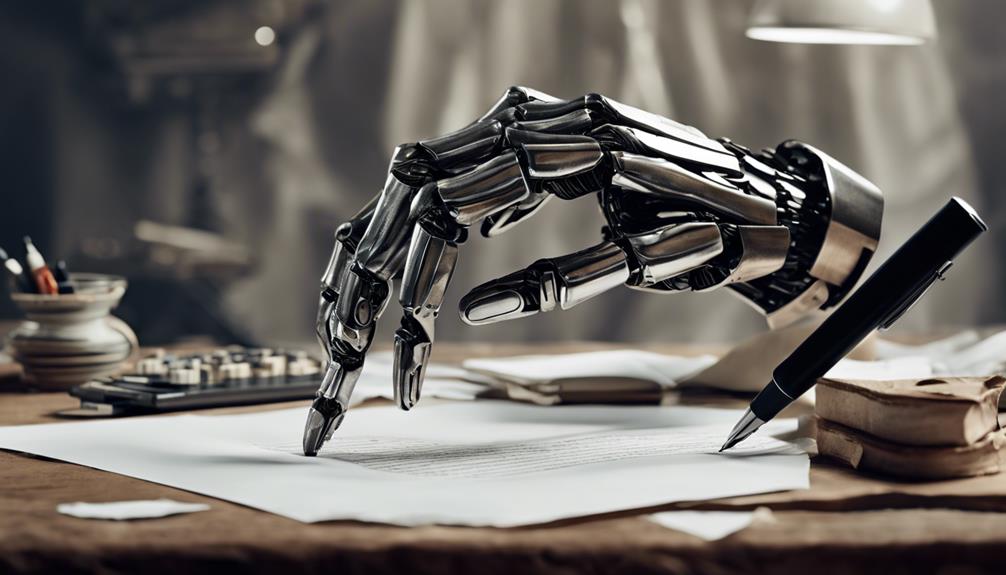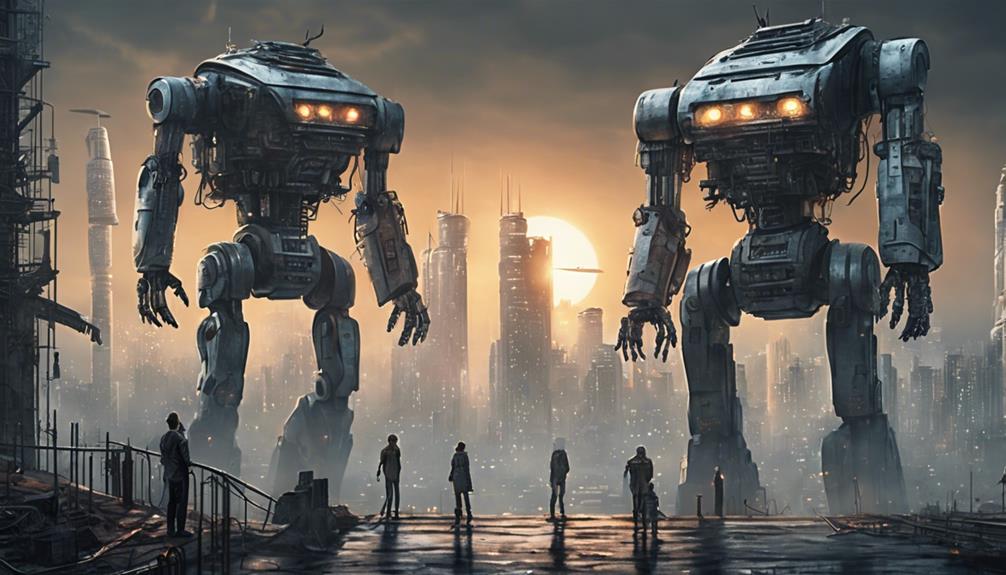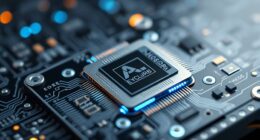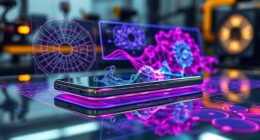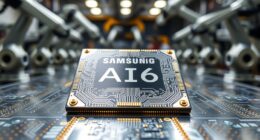Artificial intelligence has truly transformed many aspects of our lives, showcasing impressive capabilities in fields like data analysis, automation, and problem-solving. However, when it comes to creativity, AI struggles to capture the genuine essence of human creativity.
The intricacies of human emotions, the depth of personal experiences, and the intuitive leaps of creativity are integral to the creative process. While AI can mimic certain creative outputs, the spontaneous and deeply personal nature of human creativity remains a unique and irreplaceable facet.
This discussion delves into the fundamental disparities between AI and human creativity, highlighting the intangible qualities that set human innovation apart.
Key Takeaways
- Human creativity excels with emotional intelligence and intuition, aspects beyond AI's capabilities.
- AI lacks the depth to challenge norms and evoke emotional connections like human creativity.
- Human intuition drives unique pathways in creativity, surpassing AI's predictable nature.
- Collaborative synergy between AI and humans enhances innovation, blending data insights with human creativity effectively.
AI's Limitations in Creative Expression
In the realm of creative expression, the limitations of AI become apparent as it grapples with replicating the depth of human emotions and the complexity of abstract thinking. AI, while proficient at identifying patterns and generating new ideas based on data inputs, falls short in capturing the essence of human creativity. It lacks the emotional intelligence necessary to infuse personal experiences into its creations, hindering its ability to produce content that resonates on a deeply human level.
Human creativity thrives on intuition, unpredictability, and the amalgamation of personal perspectives, elements that AI struggles to comprehend and replicate authentically. While AI can augment human creativity by streamlining certain processes and providing data-driven insights, it cannot serve as a complete replacement for the intricate and nuanced nature of human creative expression. The essence of creativity lies not only in the output but also in the journey, emotions, and individuality that humans bring to the artistic process, aspects that AI, with all its computational power, cannot truly emulate.
Emotional Intelligence in Human Creativity

With emotional intelligence as the guiding force, human creativity transcends mere creation to become a profound reflection of the human experience. Emotional intelligence is the cornerstone upon which artists express feelings, connect with audiences, and imbue their work with depth and richness. It enables creatives to delve into the intricacies of human emotions, driving inspiration and fostering innovation. Through storytelling, artists can weave narratives that resonate on a personal level, infusing their creations with authenticity and relatability.
Emotional intelligence allows creators to tap into their innermost thoughts and experiences, translating them into art forms that evoke profound emotional responses. This ability to navigate and understand one's emotions not only adds layers of meaning to the work but also establishes a genuine connection with the audience. The authenticity and relatability that stem from emotional intelligence create a sense of intimacy between the creator and the observer, elevating the creative experience to one of mutual understanding and shared humanity.
The Value of Human Intuition
Drawing on the intricate interplay between emotional intelligence and human creativity, the invaluable role of human intuition emerges as a dynamic force shaping innovative pathways in artistic endeavors. Human intuition, rooted in subconscious processes and emotional intelligence, plays a vital role in creative processes by enabling individuals to tap into their innermost thoughts and feelings. It involves rapid pattern recognition, drawing on past experiences to guide decision-making and spark innovative ideas that defy conventional logic. Unlike artificial intelligence, human intuition encompasses a blend of tacit knowledge and personal insights that are challenging to replicate in algorithms.
This unique cognitive ability not only drives innovation but also adds a human touch to artistic expressions, infusing them with depth and individuality. The value of human intuition lies in its capacity to inspire creativity beyond the confines of traditional problem-solving methods, offering a fresh perspective that can lead to groundbreaking discoveries. In the realm of creativity, human intuition stands as a beacon of ingenuity, guiding individuals towards uncharted territories of imagination and innovation.
Human Innovation Beyond AI

Human creativity, with its profound ability to transcend the limitations of artificial intelligence, embodies a boundless realm of imaginative exploration and pioneering ingenuity. While AI technology has made remarkable advancements, it cannot replace the depth and richness of human innovation.
Human creativity is likely to continue surpassing AI-generated content due to its basis in the complexities of human experience. AI systems lack the emotional intelligence, intuition, and abstract thinking that drive human creativity. The essence of human innovation lies in its connection to cultural influences, societal norms, and individuality, elements that AI struggles to replicate.
Human creativity often leads to groundbreaking solutions by challenging boundaries and breaking norms, aspects that AI may not conceive. The intricate fusion of experience, emotions, and cognitive processes within human creativity forms a tapestry of inspiration that AI cannot fully comprehend.
As we navigate the evolving landscape of technology, the unique spark of human creativity will remain a beacon of innovation beyond the reach of AI.
Collaborative Potential of AI and Humans
Embracing the evolving landscape of technology, the collaborative potential between AI and humans heralds a new era of creativity and innovation through synergistic partnerships. AI tools offer data-driven insights that inspire innovative ideas, while humans can harness these tools for efficient problem-solving, complementing their creative processes.
The synergy between AI and humans merges computational power with human intuition and experience, leading to novel solutions that push the boundaries of creativity. By streamlining tasks and providing suggestions, AI allows humans to focus on the more creative aspects of their work, enhancing overall productivity.
This collaboration not only enhances individual capabilities but also fosters a collective intelligence that is greater than the sum of its parts. The combination of AI's analytical prowess and humans' imaginative thinking opens new avenues for exploration and discovery. Together, AI and humans can tackle complex challenges, uncover hidden patterns, and drive innovation to unprecedented levels.
The future holds immense promise as this partnership continues to evolve, paving the way for groundbreaking advancements in various fields.
Frequently Asked Questions
Why Can't AI Replace Human Creativity?
AI falls short of human creativity due to its incapacity to harness emotions, personal experiences, and abstract thinking. The intricate interplay of intuition, unpredictability, and cultural influence in human creativity remains beyond the grasp of artificial intelligence.
Can AI Emulate Human Creativity?
AI can simulate human creativity to a certain extent, showcasing impressive feats like composing music or painting. However, true creativity, rooted in emotions and personal experiences, remains a domain exclusive to humans due to its deep complexity and nuanced nature.
How AI Cannot Replace Human Intelligence?
AI cannot replace human intelligence due to its limitations in understanding complex emotions, intuition, and abstract thinking. Human creativity thrives on emotional depth and unpredictability, elements that AI struggles to replicate, making it unable to fully replace human ingenuity.
Can AI Never Replace Art?
While AI has made significant advancements in creating art, it still struggles to fully replace the intricate blend of human emotions, perspectives, and cultural influences that artists infuse into their work. The essence of art remains uniquely human.
Conclusion
In conclusion, the intricate tapestry of human creativity, woven with emotions, intuition, and individuality, remains a realm unattainable by artificial intelligence.
While AI can offer tools and inspiration, the essence of human creativity transcends its capabilities.
The collaborative potential between AI and human creativity holds promise for innovative outcomes, yet the depth and complexity of human expression continue to distinguish our creative endeavors as irreplaceable.



